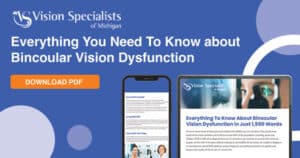What is Accommodative Dysfunction?
 Accommodative dysfunction is an eye disorder affecting the ability of the eyes to focus clearly on nearby objects. This condition stems from inadequate performance of the accommodation system, the part of the eye responsible for adjusting the lens's shape to maintain clear vision at different distances. People with this focusing muscle disorder often experience difficulty switching their focus between distant and near objects, which can lead to eyestrain, headaches, and blurred vision at varying distances.
Accommodative dysfunction is an eye disorder affecting the ability of the eyes to focus clearly on nearby objects. This condition stems from inadequate performance of the accommodation system, the part of the eye responsible for adjusting the lens's shape to maintain clear vision at different distances. People with this focusing muscle disorder often experience difficulty switching their focus between distant and near objects, which can lead to eyestrain, headaches, and blurred vision at varying distances.Accommodative Dysfunction Causes
The causes of accommodative dysfunction vary and can include both physiological and external factors. Common causes are:- Age-related changes: As people age, the eye’s lens becomes less flexible, making it harder to focus on close objects — a condition known as presbyopia.
- Prolonged near work: Spending excessive time on activities that require close focus, such as reading or using computers and smartphones, can strain the eyes and lead to accommodative dysfunction.
- Underlying health conditions: People with conditions like diabetes, multiple sclerosis, and cardiovascular diseases have a higher chance of developing accommodative dysfunction.
- Medications: Certain medications, especially those with anticholinergic effects, can impair accommodative ability.
- Trauma or surgery: Physical injuries to the eye or certain types of eye surgeries can disrupt the accommodation system.
Accommodative Dysfunction Symptoms
The symptoms of accommodative dysfunction can vary from person to person but typically include:- Blurry vision: Difficulty in focusing on close objects, leading to intermittent blurred vision that becomes clearer after looking away or resting the eyes. This makes it difficult to sustain focus on close objects for extended periods.
- Eye strain: Experiencing tired eyes, especially after prolonged periods of near tasks such as reading or using digital devices. Visually demanding tasks are commonly followed by eye strain.
- Headaches: Frequent headaches can occur, often associated with intense focus on near work or activities that require constant shifting of focus. People may need to take frequent breaks when performing near work.
- Difficulty in shifting focus: A noticeable delay or discomfort when shifting focus from objects at one distance to another, often felt when looking from a book to a distant board.
- Sensitivity to light: Increased discomfort in bright environments or when exposed to intense lighting. Bright light can bring the eyes visual stress and cause pain.
- Double vision: In more severe cases, the strain on the eye's focusing ability may lead to double vision, which can impact daily activities significantly.
- Poor reading comprehension: Children may also show poor reading fluency because of undiagnosed accommodative dysfunction.
Accommodative Dysfunction Treatment Options
Treating accommodative dysfunction involves several strategies aimed at improving the eyes' ability to focus and reducing symptoms. Treatment options include:- Eyeglasses or contact lenses: Prescription lenses can be used to correct focus issues. Bifocal or progressive lenses are particularly beneficial for people with accommodative dysfunction as they provide different levels of focus correction.
- Vision therapy: This involves a series of visual exercises that help improve the coordination and focusing capabilities of the eyes. Vision therapy is often tailored to the individual and supervised by an eye care professional.
- Pharmacological treatment: In some cases, eye drops that temporarily alter the eye’s ability to focus can be used to manage symptoms.
- Lifestyle changes: Reducing the time spent on close-up activities, taking regular breaks during prolonged near work, and using proper lighting can help alleviate symptoms.
Binocular Vision Dysfunction (BVD)
While discussing accommodative dysfunction, it's important to also touch on binocular vision dysfunction, a related condition where the eyes struggle to work together effectively. This can lead to double vision, headaches, and dizziness which can be mistaken for accommodative dysfunction. The treatment for binocular vision dysfunction is specialized corrective prism lenses.Frequently Asked Questions
Is accommodative dysfunction treatable?
Yes, accommodative dysfunction is treatable. With proper diagnosis and a tailored treatment plan, most people can manage or resolve their symptoms effectively.How do you fix accommodative insufficiency?
Accommodative insufficiency, a form of accommodative dysfunction where the eyes do not focus well on close objects, can be treated with corrective lenses, vision therapy, and lifestyle adjustments to reduce strain on the eyes.How rare is accommodative insufficiency?
Accommodative insufficiency is not extremely rare. According to the National Institutes of Health (NIH), it occurs in as much as 10% of the population. This statistic highlights the importance of awareness and proper diagnosis.Is accommodative insufficiency permanent?
No, accommodative insufficiency is not necessarily permanent. With appropriate treatment strategies, individuals can often overcome this condition or greatly reduce its impact on their daily lives.Take the Binocular Vision Dysfunction Test
Accommodative dysfunction and related visual impairments can significantly affect one's quality of life, but with the right approach, they can be managed effectively. Understanding the symptoms, seeking timely medical advice, and following a personalized treatment plan are crucial steps in dealing with this condition. If you suspect you or someone you know might be suffering from accommodative dysfunction or BVD, take the BVD test online today!Filed Under:







